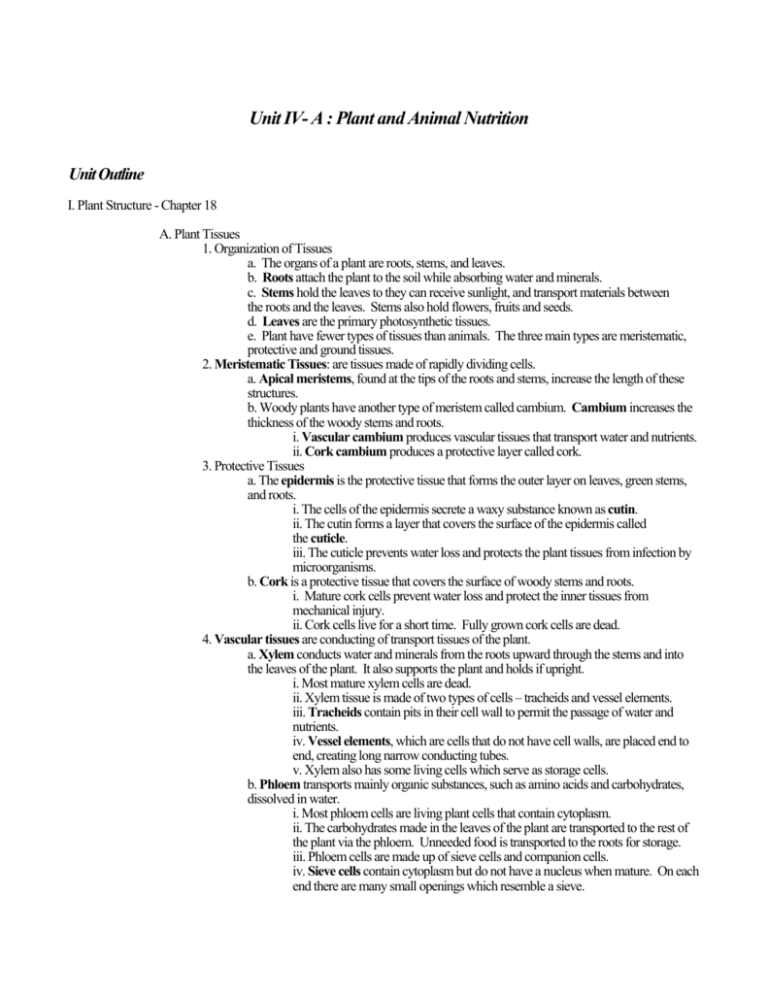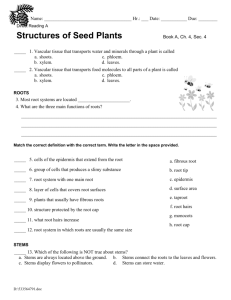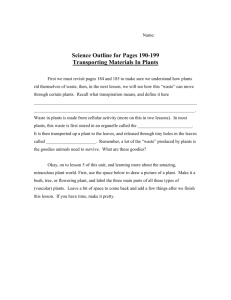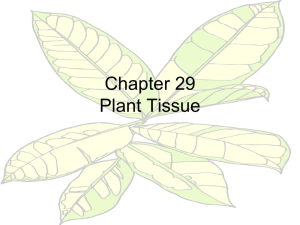Unit III - Evolution
advertisement

Unit IV- A : Plant and Animal Nutrition Unit Outline I. Plant Structure - Chapter 18 A. Plant Tissues 1. Organization of Tissues a. The organs of a plant are roots, stems, and leaves. b. Roots attach the plant to the soil while absorbing water and minerals. c. Stems hold the leaves to they can receive sunlight, and transport materials between the roots and the leaves. Stems also hold flowers, fruits and seeds. d. Leaves are the primary photosynthetic tissues. e. Plant have fewer types of tissues than animals. The three main types are meristematic, protective and ground tissues. 2. Meristematic Tissues: are tissues made of rapidly dividing cells. a. Apical meristems, found at the tips of the roots and stems, increase the length of these structures. b. Woody plants have another type of meristem called cambium. Cambium increases the thickness of the woody stems and roots. i. Vascular cambium produces vascular tissues that transport water and nutrients. ii. Cork cambium produces a protective layer called cork. 3. Protective Tissues a. The epidermis is the protective tissue that forms the outer layer on leaves, green stems, and roots. i. The cells of the epidermis secrete a waxy substance known as cutin. ii. The cutin forms a layer that covers the surface of the epidermis called the cuticle. iii. The cuticle prevents water loss and protects the plant tissues from infection by microorganisms. b. Cork is a protective tissue that covers the surface of woody stems and roots. i. Mature cork cells prevent water loss and protect the inner tissues from mechanical injury. ii. Cork cells live for a short time. Fully grown cork cells are dead. 4. Vascular tissues are conducting of transport tissues of the plant. a. Xylem conducts water and minerals from the roots upward through the stems and into the leaves of the plant. It also supports the plant and holds if upright. i. Most mature xylem cells are dead. ii. Xylem tissue is made of two types of cells – tracheids and vessel elements. iii. Tracheids contain pits in their cell wall to permit the passage of water and nutrients. iv. Vessel elements, which are cells that do not have cell walls, are placed end to end, creating long narrow conducting tubes. v. Xylem also has some living cells which serve as storage cells. b. Phloem transports mainly organic substances, such as amino acids and carbohydrates, dissolved in water. i. Most phloem cells are living plant cells that contain cytoplasm. ii. The carbohydrates made in the leaves of the plant are transported to the rest of the plant via the phloem. Unneeded food is transported to the roots for storage. iii. Phloem cells are made up of sieve cells and companion cells. iv. Sieve cells contain cytoplasm but do not have a nucleus when mature. On each end there are many small openings which resemble a sieve. v. Companion cells, which do have a nucleus, connect neighboring sieve cells. It is thought that these companion cells control the flow of materials through the sieve cells. 5. Ground tissues are tissues that assist with the production and storage of food, and act to support the plant. There are three ground tissues – parenchyma, collenchyma and sclerenchyma. a. Parenchyma cells are unspecialized cells with thin cell walls. i. these cells are found in leaves, stems, roots, and fruits. ii. In leaves, these cells are photosynthetic. iii. In roots, stems and fruits, these cells are food storage structures. b. Collenchyma cells are long cells with strong, but flexible cell walls. They are mainly used to support stems and leaves. c. Sclerenchyma cells have thick, inflexible cells walls stiffened with a substance called lignin. i. Lignin is what makes wood hard and rigid. ii. In mature sclerenchyma cells the cell wall is so thick that the spaces inside the cells are nearly eliminated. B. Roots 1. Types of Roots a. Taproots grow deep into the ground and become thick and fleshy. Oaks, carrots, turnips, and dandelions all have taproots. b. Fibrous root systems are made up of numerous roots, many of which are nearly equal in size. Corn and grasses have fibrous root systems. c. Both taproot and fibrous root systems are modified for food storage in some plants. The carrot, radish and beet are all taproots modified for food storage. Sweet potatoes and tapioca are fibrous storage roots. d. Adventitious roots are root systems that grow from the stems or leaves of plants. i. Prop roots grow from the stem down to the soil to help brace the plant. (Corn) ii. Climbing roots grow out from the stem, and help fasten the plant to a solid support. (poison ivy) iii. Aerial roots absorb moisture directly from the air. (Spanish moss) 2. Root Growth: Roots only increase in length at the root tips. a. The root cap is a thimble shaped group of cells that form a protective covering over the rest of the root tip. b. The meristematic zone is the region of rapidly dividing cells just behind the root cap. c. The elongation zone is composed of cells which were produced earlier in the meristematic zone. These cells enlarge, pushing the root tip forward. d. The maturation zone is the location where cells begin to differentiate, developing into specialized cells. 3. Root Structure and Function: A cross section of the maturation zone shows that the root is made of many distinct tissue layers. a. The outer most layer called the epidermis is one cell layer thick. i. Absorption of water and minerals from the soil is the primary function of the epidermis. ii. Root hairs, which increase the surface area of the root surface are made of epidermal cells. b. The cortex is located just inside the epidermis. i. The cortex consists of parenchyma cells and functions to store food in the form of amylase (starch) ii. The cortex also conducts water and nutrients to the conducting tissues of the center of the root. iii. The inner most layer of cortex cells is called the endodermis. The endodermis controls the movement of water into the central cylinder. c. The vascular cylinder, or central cylinder, is the core of the dicot root. i. The vascular cylinder is surrounded by a layer of parenchyma cells called the pericycle. ii. All secondary roots grow from this pericycle layer. iii. At the center of the vascular cylinder are the conducting tissues phloem and xylem. iv. The vascular cambium develops between the xylem and phloem and adds new xylem to its inside, and new phloem to its outside. 4. Roots and Microorganisms: Plants often have bacteria or fungi living within their roots. This symbiotic relationship is mutually beneficial to both organisms. a. Legumes, or members of the pea family, have nitrogen fixing bacteria inside their roots. b. A mycorrhiza is a plant root that is growing in symbiotic relationship with a fungus. i. The fungus obtains the necessary nutrients for growth and development from the plant. ii. In turn, the fungi dramatically increase the surface area of the roots and increase the ability of the plant to absorb necessary materials form the soil. C. Stems and Leaves 1. Types of Stems: a. Herbaceous stems are soft, juicy, green, and often photosynthetic. i. All tissues of the stem are produced by the apical meristem. ii. The organization of these tissues depends on the type of plant. iii. The epidermis, which is the outer most layer is dotted with small openings called the stomates. These stomates allow for the exchange of gasses between the tissues inside the stem and the atmosphere. iv. Inside the epidermis of the dicot is the cortex. The cortex serves as food storage and to support the stem. v. Inside the cortex is a ring of vascular bundles. Each bundle is made of an outer group of phloem, and an inner group of xylem cells. vi. The vascular cambium, found between the xylem and phloem, produces these tissues. vii. The central region of the stem is called the pith. The pith is made of parenchyma cells that store food. b. Woody Stems – Internal Structure: Woody stems are made of thick, tough tissue that you know of as wood. i. Almost all woody plants are dicots. ii. The growth in with of woody stems is a result of new tissues that are produced by the vascular cambium. iii. Xylem, which is produced on the inside of the vascular cambium forms the annual rings that can be seen inside the woody stem. iv. As phloem is produced to the outside of the vascular cambium the old phloem is pushed toward the outside of the woody stem. c. Woody Stems – External Structure: i. At the tip of the twig is the terminal bud. Enclosed in bud scales, the terminal bud is made of meristematic tissue. ii. Lenticels are holes that pass through the cork tissue. They allow for the exchange of oxygen and carbon dioxide. iii. Lateral buds, or axillary buds, are found just above the point where a leaf is or was attached to the stem. 3. Types of Leaves: a. A typical leaf has a thin, flat blade, and a stalk, or petiole. b. A simple leaf has only one blade and one petiole. c. In a compound leaf the blade is divided into several parts, or leaflets. 4. Internal Leaf Structure: a. The cuticle: The outermost surface of the leaf is called the cuticle. It is made of a clear waxy substance called cutin.. i. The cuticle slows water loss and protects the plant from infection. ii. The cuticle is produced by the upper epidermis. b. The epidermis is a single layer of cells that fit together like a puzzle. The upper epidermis is found on the upper surface of the leaf, and the lower epidermis is found on the lower surface. i. Imbedded in the cuticle are specialized cells called the guard cells. ii. Guard cells are kidney shaped cells that regulate the opening and closing of the stomates. This process will be described in Ch. 19. c. The mesophyll layer is composed of the palisade and the spongy layers. d. The palisade mesophyll is one or two cells thick. It is composed of tightly packed photosynthetic cells. It is the primary photosynthetic layer of the leaf. e. The spongy mesophyll is made of a loosely packed layer of photosynthetic cells. In between the cells of the spongy mesophyl are air spaces. These air spaces assist in the gas exchange of the leaf. f. Within the mesophyl is a network of veins. These veins contain the phloem and xylem crutial to the transport of materials throughout the plant. 5. Evolution of Plants a. Plants evolved around 440 million years ago. These early plants evolved in water. b. In water plants did not have to contend with support and water loss. c. As plants invaded land, these issues had to be addressed. Roots, stems and leaves helped plants adapt to land.








